Nestle's Accounting and Financial Reporting Analysis for the year 2020
VerifiedAdded on 2023/06/17
|20
|3659
|260
Report
AI Summary
This report provides a comprehensive financial analysis of Nestle, focusing on its accounting and reporting practices for the year 2020. It includes an assessment of the company's background, consolidated statements of financial position, income statements, and cash flow statements. The analysis covers key aspects such as the board of directors, executive management, and committees, as well as an examination of the balance sheet, accounting equation, and working capital. The report also delves into the company's profitability, solvency, and overall financial performance, including a common size analysis, trend analysis, and ratio analysis. Furthermore, it evaluates Nestle's prospects and discusses the ethics and corporate governance structures in place. The report concludes with an overview of Nestle's financial health and its strategic positioning in the market.
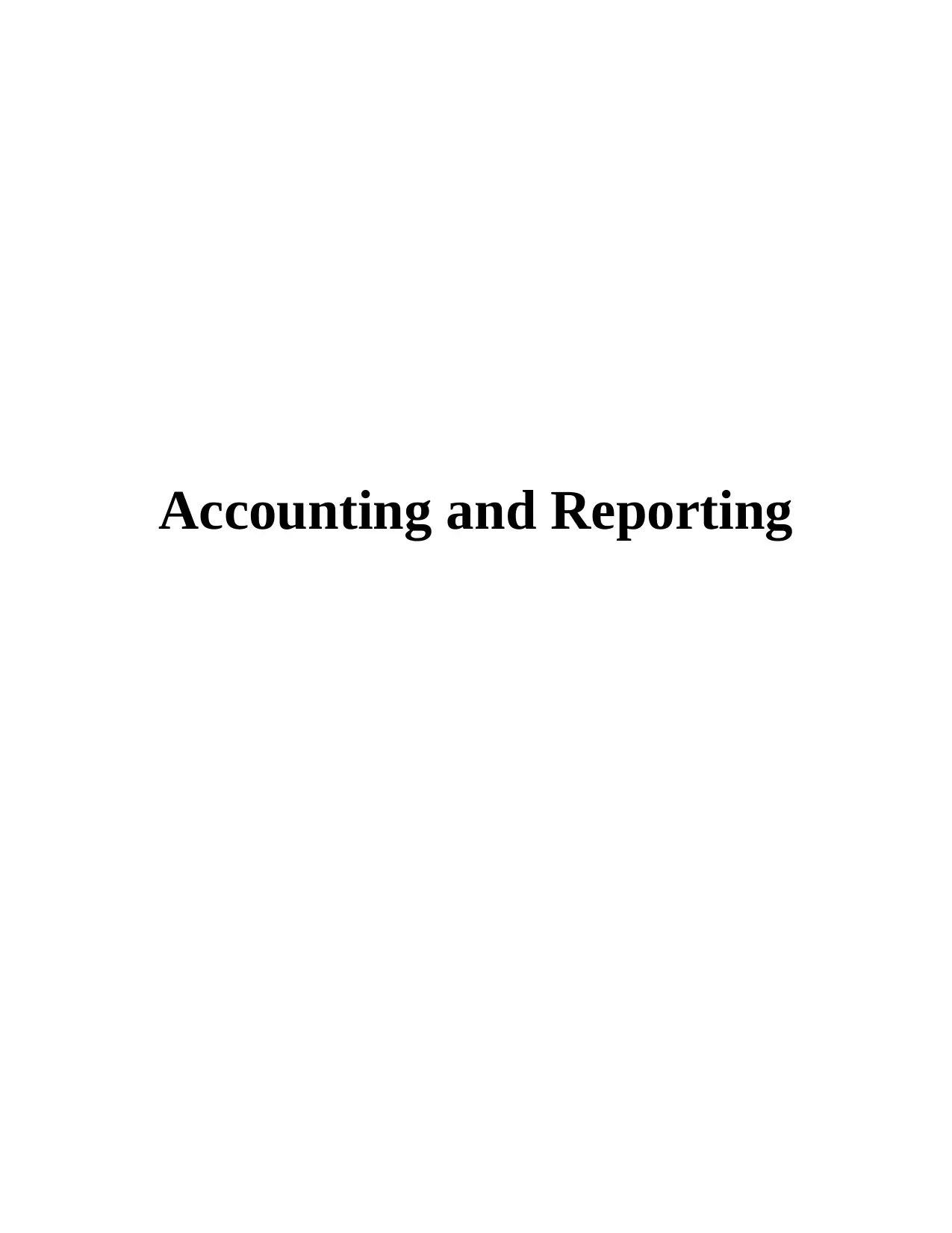
Accounting and Reporting
Paraphrase This Document
Need a fresh take? Get an instant paraphrase of this document with our AI Paraphraser
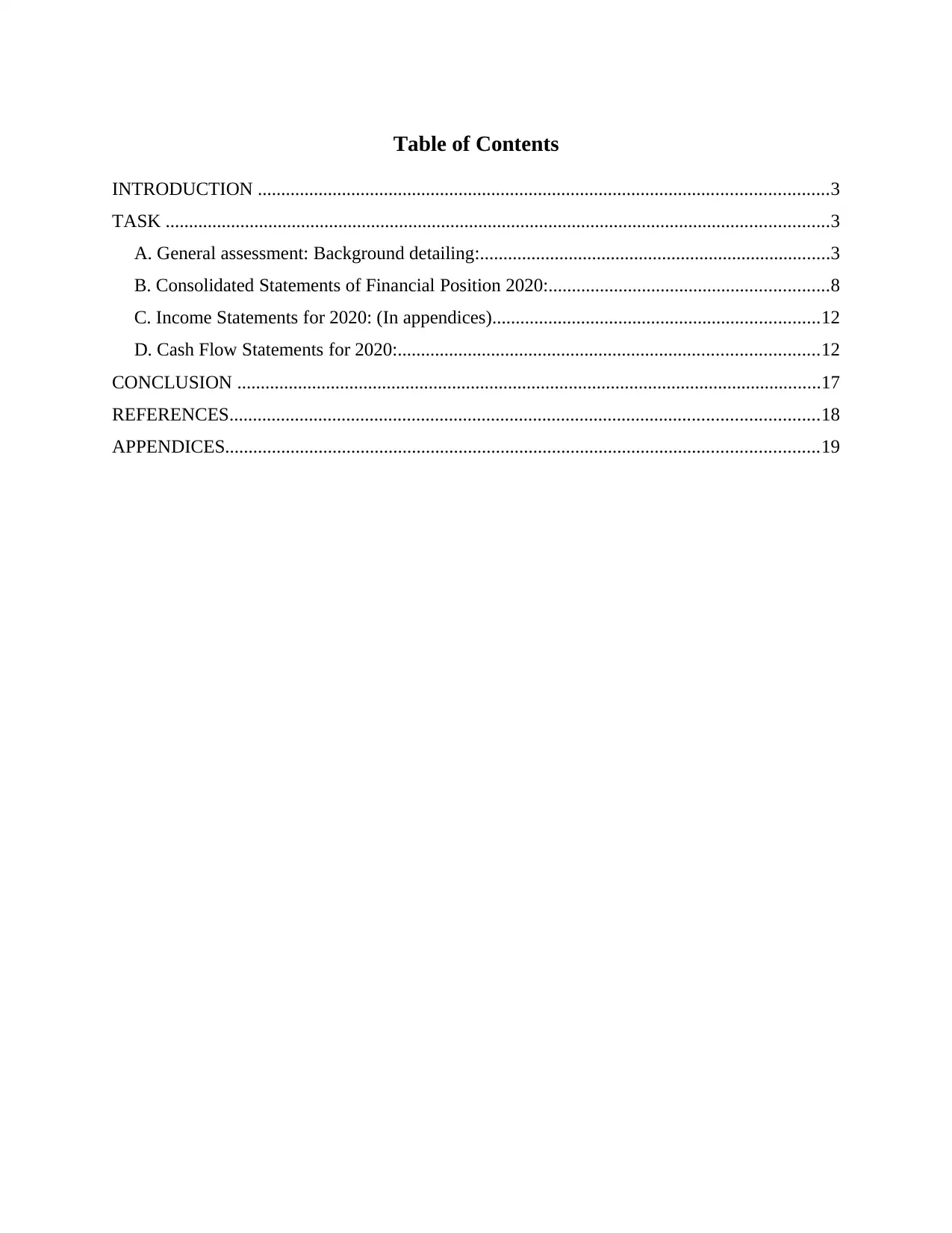
Table of Contents
INTRODUCTION ..........................................................................................................................3
TASK ..............................................................................................................................................3
A. General assessment: Background detailing:...........................................................................3
B. Consolidated Statements of Financial Position 2020:............................................................8
C. Income Statements for 2020: (In appendices)......................................................................12
D. Cash Flow Statements for 2020:..........................................................................................12
CONCLUSION .............................................................................................................................17
REFERENCES..............................................................................................................................18
APPENDICES...............................................................................................................................19
INTRODUCTION ..........................................................................................................................3
TASK ..............................................................................................................................................3
A. General assessment: Background detailing:...........................................................................3
B. Consolidated Statements of Financial Position 2020:............................................................8
C. Income Statements for 2020: (In appendices)......................................................................12
D. Cash Flow Statements for 2020:..........................................................................................12
CONCLUSION .............................................................................................................................17
REFERENCES..............................................................................................................................18
APPENDICES...............................................................................................................................19
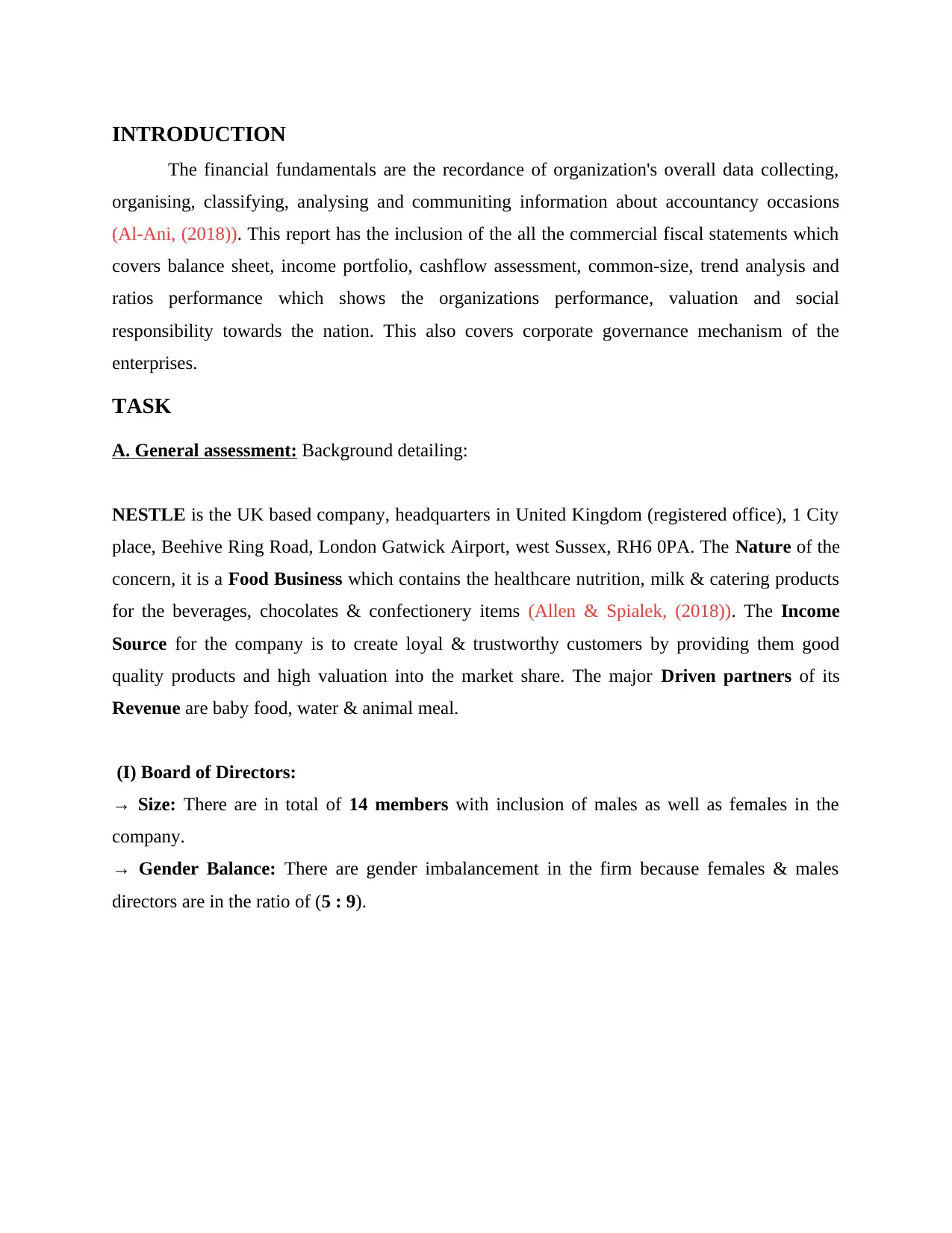
INTRODUCTION
The financial fundamentals are the recordance of organization's overall data collecting,
organising, classifying, analysing and communiting information about accountancy occasions
(Al-Ani, (2018)). This report has the inclusion of the all the commercial fiscal statements which
covers balance sheet, income portfolio, cashflow assessment, common-size, trend analysis and
ratios performance which shows the organizations performance, valuation and social
responsibility towards the nation. This also covers corporate governance mechanism of the
enterprises.
TASK
A. General assessment: Background detailing:
NESTLE is the UK based company, headquarters in United Kingdom (registered office), 1 City
place, Beehive Ring Road, London Gatwick Airport, west Sussex, RH6 0PA. The Nature of the
concern, it is a Food Business which contains the healthcare nutrition, milk & catering products
for the beverages, chocolates & confectionery items (Allen & Spialek, (2018)). The Income
Source for the company is to create loyal & trustworthy customers by providing them good
quality products and high valuation into the market share. The major Driven partners of its
Revenue are baby food, water & animal meal.
(I) Board of Directors:
→ Size: There are in total of 14 members with inclusion of males as well as females in the
company.
→ Gender Balance: There are gender imbalancement in the firm because females & males
directors are in the ratio of (5 : 9).
The financial fundamentals are the recordance of organization's overall data collecting,
organising, classifying, analysing and communiting information about accountancy occasions
(Al-Ani, (2018)). This report has the inclusion of the all the commercial fiscal statements which
covers balance sheet, income portfolio, cashflow assessment, common-size, trend analysis and
ratios performance which shows the organizations performance, valuation and social
responsibility towards the nation. This also covers corporate governance mechanism of the
enterprises.
TASK
A. General assessment: Background detailing:
NESTLE is the UK based company, headquarters in United Kingdom (registered office), 1 City
place, Beehive Ring Road, London Gatwick Airport, west Sussex, RH6 0PA. The Nature of the
concern, it is a Food Business which contains the healthcare nutrition, milk & catering products
for the beverages, chocolates & confectionery items (Allen & Spialek, (2018)). The Income
Source for the company is to create loyal & trustworthy customers by providing them good
quality products and high valuation into the market share. The major Driven partners of its
Revenue are baby food, water & animal meal.
(I) Board of Directors:
→ Size: There are in total of 14 members with inclusion of males as well as females in the
company.
→ Gender Balance: There are gender imbalancement in the firm because females & males
directors are in the ratio of (5 : 9).
⊘ This is a preview!⊘
Do you want full access?
Subscribe today to unlock all pages.

Trusted by 1+ million students worldwide
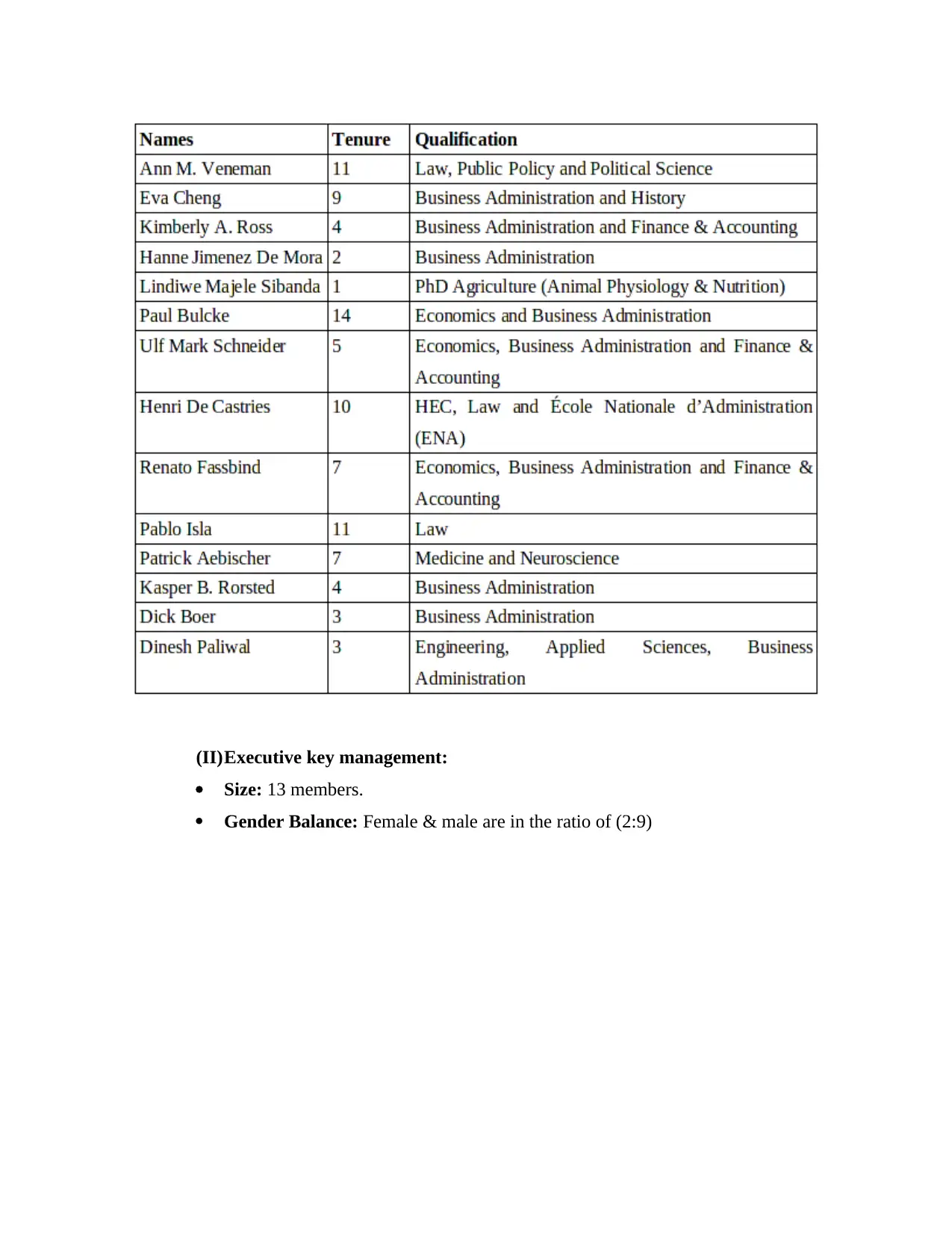
(II)Executive key management:
Size: 13 members.
Gender Balance: Female & male are in the ratio of (2:9)
Size: 13 members.
Gender Balance: Female & male are in the ratio of (2:9)
Paraphrase This Document
Need a fresh take? Get an instant paraphrase of this document with our AI Paraphraser
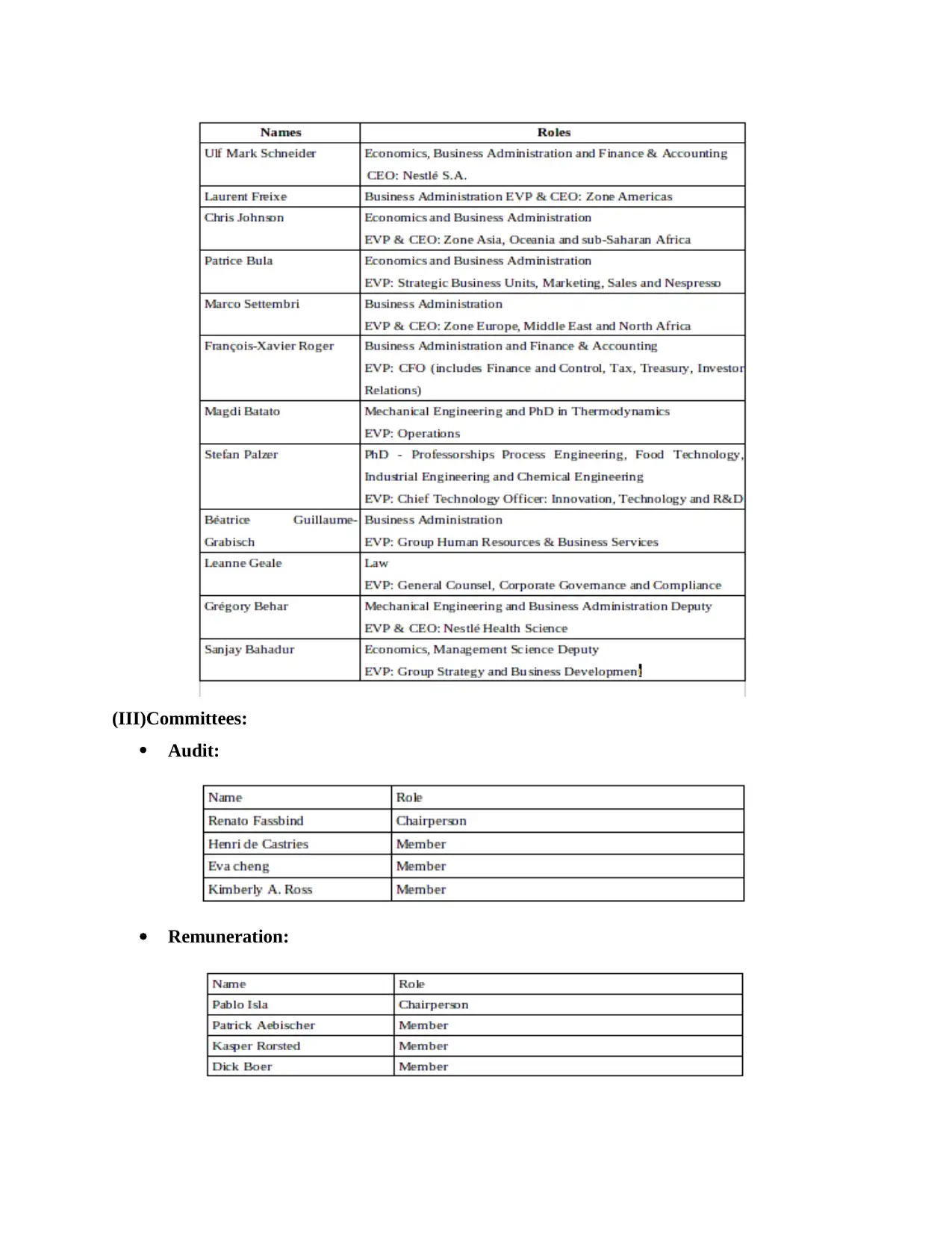
(III)Committees:
Audit:
Remuneration:
Audit:
Remuneration:
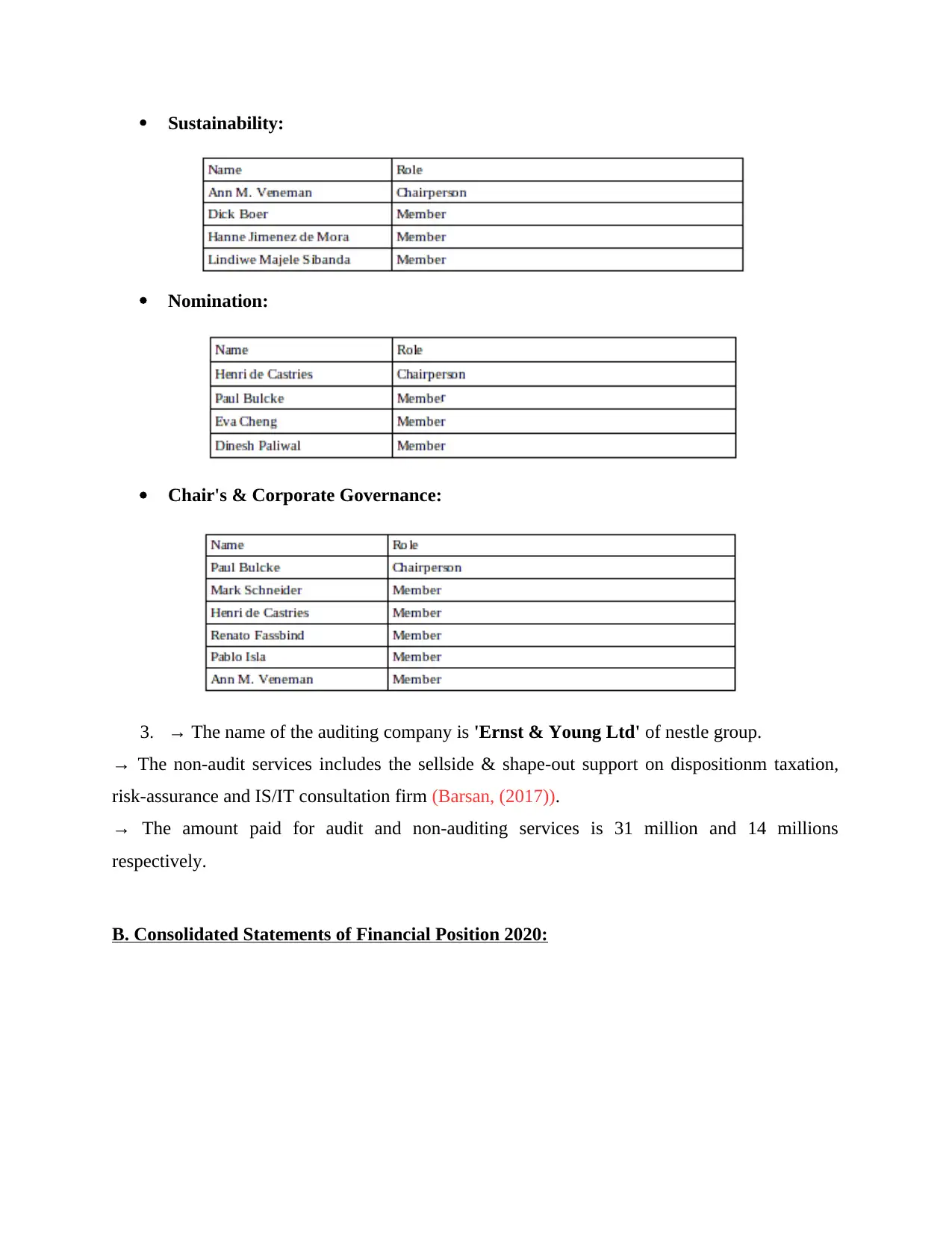
Sustainability:
Nomination:
Chair's & Corporate Governance:
3. → The name of the auditing company is 'Ernst & Young Ltd' of nestle group.
→ The non-audit services includes the sellside & shape-out support on dispositionm taxation,
risk-assurance and IS/IT consultation firm (Barsan, (2017)).
→ The amount paid for audit and non-auditing services is 31 million and 14 millions
respectively.
B. Consolidated Statements of Financial Position 2020:
Nomination:
Chair's & Corporate Governance:
3. → The name of the auditing company is 'Ernst & Young Ltd' of nestle group.
→ The non-audit services includes the sellside & shape-out support on dispositionm taxation,
risk-assurance and IS/IT consultation firm (Barsan, (2017)).
→ The amount paid for audit and non-auditing services is 31 million and 14 millions
respectively.
B. Consolidated Statements of Financial Position 2020:
⊘ This is a preview!⊘
Do you want full access?
Subscribe today to unlock all pages.

Trusted by 1+ million students worldwide
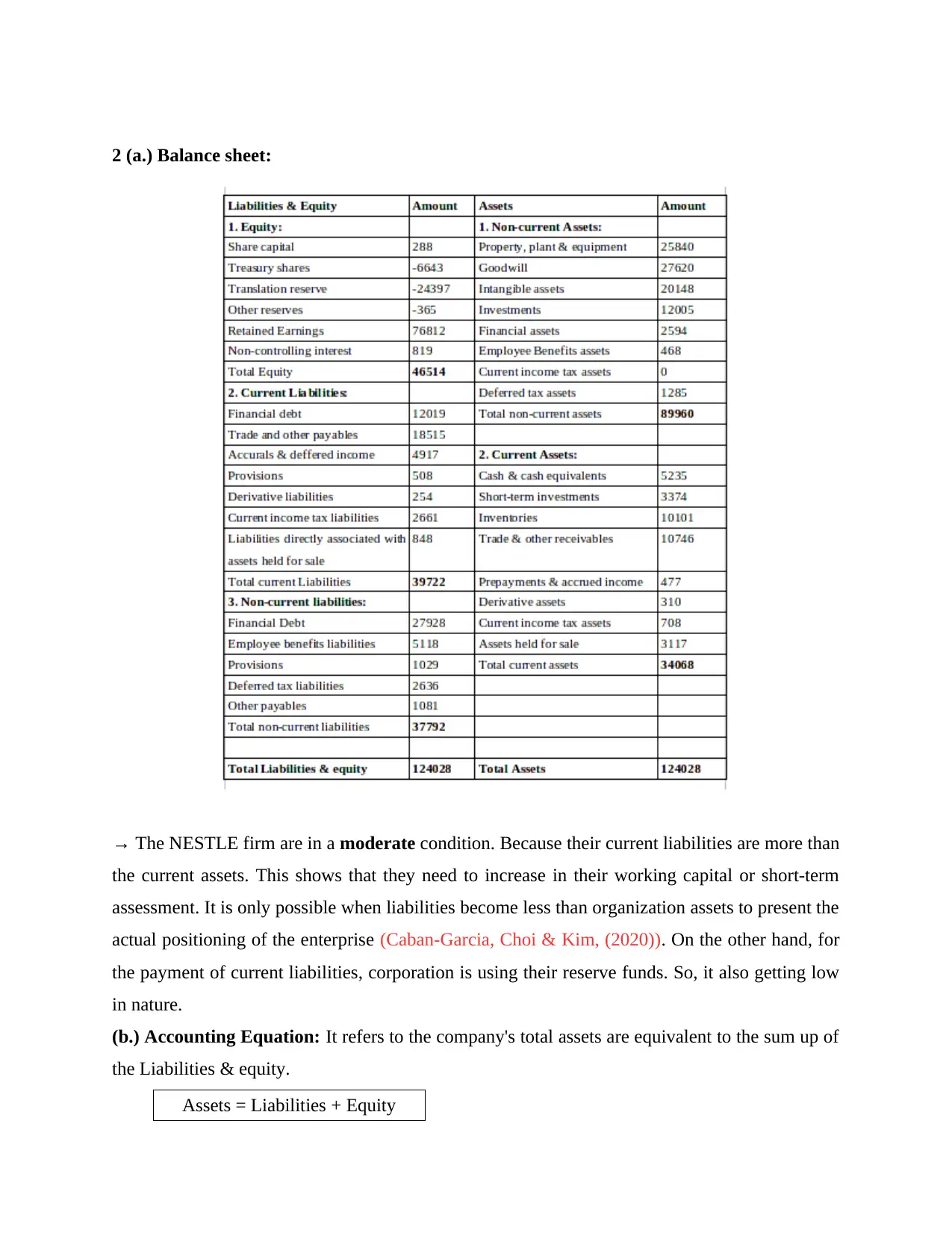
2 (a.) Balance sheet:
→ The NESTLE firm are in a moderate condition. Because their current liabilities are more than
the current assets. This shows that they need to increase in their working capital or short-term
assessment. It is only possible when liabilities become less than organization assets to present the
actual positioning of the enterprise (Caban-Garcia, Choi & Kim, (2020)). On the other hand, for
the payment of current liabilities, corporation is using their reserve funds. So, it also getting low
in nature.
(b.) Accounting Equation: It refers to the company's total assets are equivalent to the sum up of
the Liabilities & equity.
Assets = Liabilities + Equity
→ The NESTLE firm are in a moderate condition. Because their current liabilities are more than
the current assets. This shows that they need to increase in their working capital or short-term
assessment. It is only possible when liabilities become less than organization assets to present the
actual positioning of the enterprise (Caban-Garcia, Choi & Kim, (2020)). On the other hand, for
the payment of current liabilities, corporation is using their reserve funds. So, it also getting low
in nature.
(b.) Accounting Equation: It refers to the company's total assets are equivalent to the sum up of
the Liabilities & equity.
Assets = Liabilities + Equity
Paraphrase This Document
Need a fresh take? Get an instant paraphrase of this document with our AI Paraphraser
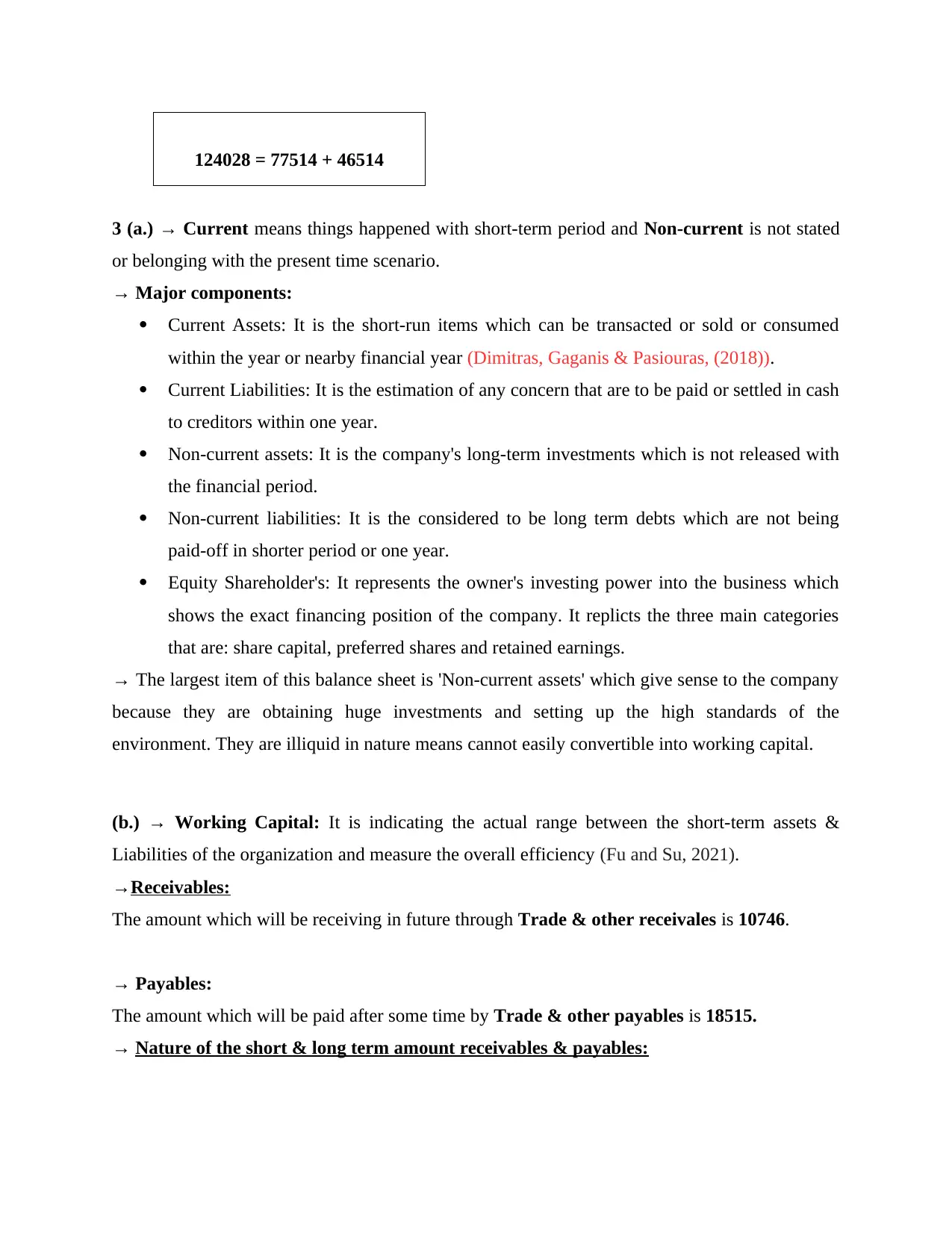
124028 = 77514 + 46514
3 (a.) → Current means things happened with short-term period and Non-current is not stated
or belonging with the present time scenario.
→ Major components:
Current Assets: It is the short-run items which can be transacted or sold or consumed
within the year or nearby financial year (Dimitras, Gaganis & Pasiouras, (2018)).
Current Liabilities: It is the estimation of any concern that are to be paid or settled in cash
to creditors within one year.
Non-current assets: It is the company's long-term investments which is not released with
the financial period.
Non-current liabilities: It is the considered to be long term debts which are not being
paid-off in shorter period or one year.
Equity Shareholder's: It represents the owner's investing power into the business which
shows the exact financing position of the company. It replicts the three main categories
that are: share capital, preferred shares and retained earnings.
→ The largest item of this balance sheet is 'Non-current assets' which give sense to the company
because they are obtaining huge investments and setting up the high standards of the
environment. They are illiquid in nature means cannot easily convertible into working capital.
(b.) → Working Capital: It is indicating the actual range between the short-term assets &
Liabilities of the organization and measure the overall efficiency (Fu and Su, 2021).
→Receivables:
The amount which will be receiving in future through Trade & other receivales is 10746.
→ Payables:
The amount which will be paid after some time by Trade & other payables is 18515.
→ Nature of the short & long term amount receivables & payables:
3 (a.) → Current means things happened with short-term period and Non-current is not stated
or belonging with the present time scenario.
→ Major components:
Current Assets: It is the short-run items which can be transacted or sold or consumed
within the year or nearby financial year (Dimitras, Gaganis & Pasiouras, (2018)).
Current Liabilities: It is the estimation of any concern that are to be paid or settled in cash
to creditors within one year.
Non-current assets: It is the company's long-term investments which is not released with
the financial period.
Non-current liabilities: It is the considered to be long term debts which are not being
paid-off in shorter period or one year.
Equity Shareholder's: It represents the owner's investing power into the business which
shows the exact financing position of the company. It replicts the three main categories
that are: share capital, preferred shares and retained earnings.
→ The largest item of this balance sheet is 'Non-current assets' which give sense to the company
because they are obtaining huge investments and setting up the high standards of the
environment. They are illiquid in nature means cannot easily convertible into working capital.
(b.) → Working Capital: It is indicating the actual range between the short-term assets &
Liabilities of the organization and measure the overall efficiency (Fu and Su, 2021).
→Receivables:
The amount which will be receiving in future through Trade & other receivales is 10746.
→ Payables:
The amount which will be paid after some time by Trade & other payables is 18515.
→ Nature of the short & long term amount receivables & payables:
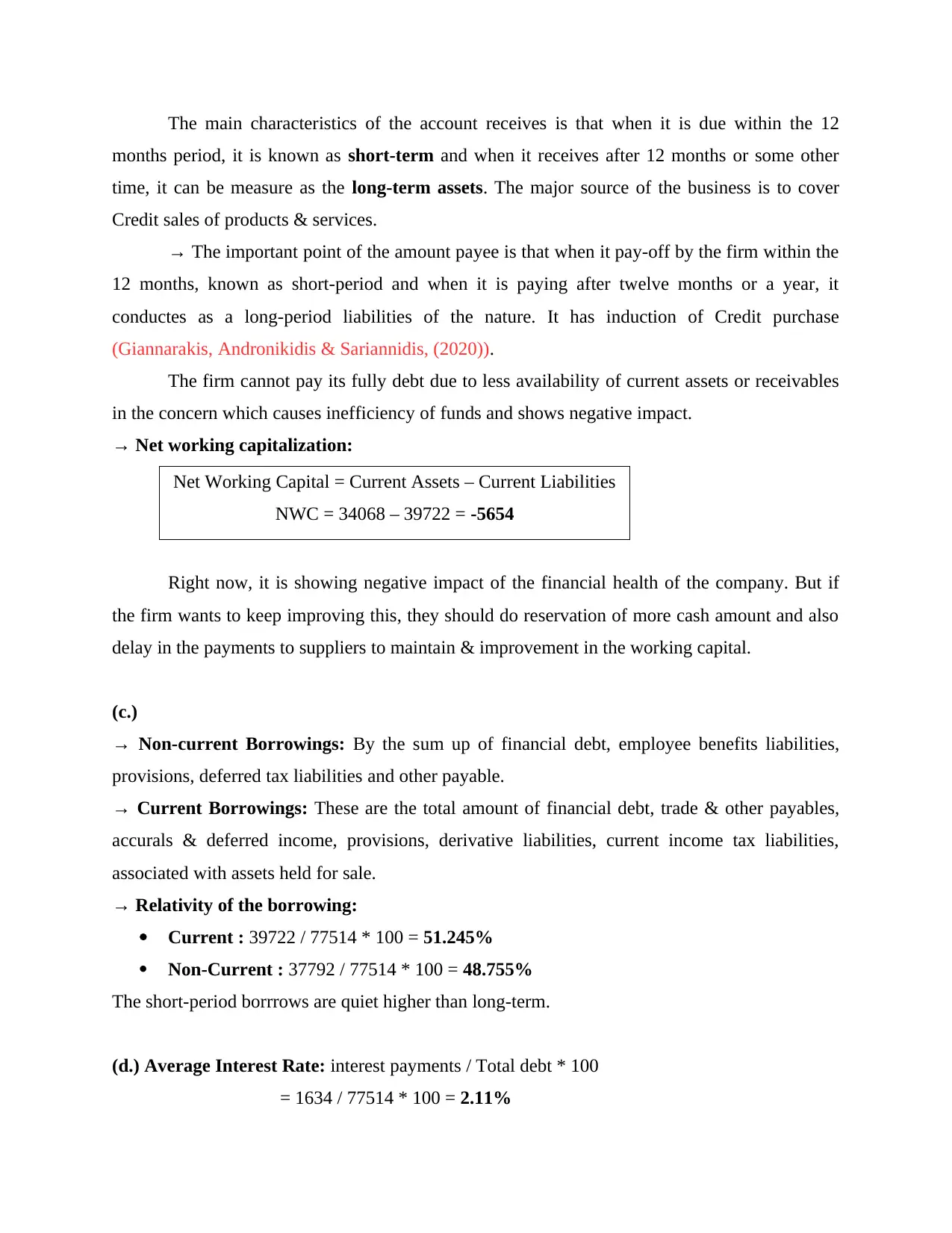
The main characteristics of the account receives is that when it is due within the 12
months period, it is known as short-term and when it receives after 12 months or some other
time, it can be measure as the long-term assets. The major source of the business is to cover
Credit sales of products & services.
→ The important point of the amount payee is that when it pay-off by the firm within the
12 months, known as short-period and when it is paying after twelve months or a year, it
conductes as a long-period liabilities of the nature. It has induction of Credit purchase
(Giannarakis, Andronikidis & Sariannidis, (2020)).
The firm cannot pay its fully debt due to less availability of current assets or receivables
in the concern which causes inefficiency of funds and shows negative impact.
→ Net working capitalization:
Net Working Capital = Current Assets – Current Liabilities
NWC = 34068 – 39722 = -5654
Right now, it is showing negative impact of the financial health of the company. But if
the firm wants to keep improving this, they should do reservation of more cash amount and also
delay in the payments to suppliers to maintain & improvement in the working capital.
(c.)
→ Non-current Borrowings: By the sum up of financial debt, employee benefits liabilities,
provisions, deferred tax liabilities and other payable.
→ Current Borrowings: These are the total amount of financial debt, trade & other payables,
accurals & deferred income, provisions, derivative liabilities, current income tax liabilities,
associated with assets held for sale.
→ Relativity of the borrowing:
Current : 39722 / 77514 * 100 = 51.245%
Non-Current : 37792 / 77514 * 100 = 48.755%
The short-period borrrows are quiet higher than long-term.
(d.) Average Interest Rate: interest payments / Total debt * 100
= 1634 / 77514 * 100 = 2.11%
months period, it is known as short-term and when it receives after 12 months or some other
time, it can be measure as the long-term assets. The major source of the business is to cover
Credit sales of products & services.
→ The important point of the amount payee is that when it pay-off by the firm within the
12 months, known as short-period and when it is paying after twelve months or a year, it
conductes as a long-period liabilities of the nature. It has induction of Credit purchase
(Giannarakis, Andronikidis & Sariannidis, (2020)).
The firm cannot pay its fully debt due to less availability of current assets or receivables
in the concern which causes inefficiency of funds and shows negative impact.
→ Net working capitalization:
Net Working Capital = Current Assets – Current Liabilities
NWC = 34068 – 39722 = -5654
Right now, it is showing negative impact of the financial health of the company. But if
the firm wants to keep improving this, they should do reservation of more cash amount and also
delay in the payments to suppliers to maintain & improvement in the working capital.
(c.)
→ Non-current Borrowings: By the sum up of financial debt, employee benefits liabilities,
provisions, deferred tax liabilities and other payable.
→ Current Borrowings: These are the total amount of financial debt, trade & other payables,
accurals & deferred income, provisions, derivative liabilities, current income tax liabilities,
associated with assets held for sale.
→ Relativity of the borrowing:
Current : 39722 / 77514 * 100 = 51.245%
Non-Current : 37792 / 77514 * 100 = 48.755%
The short-period borrrows are quiet higher than long-term.
(d.) Average Interest Rate: interest payments / Total debt * 100
= 1634 / 77514 * 100 = 2.11%
⊘ This is a preview!⊘
Do you want full access?
Subscribe today to unlock all pages.

Trusted by 1+ million students worldwide
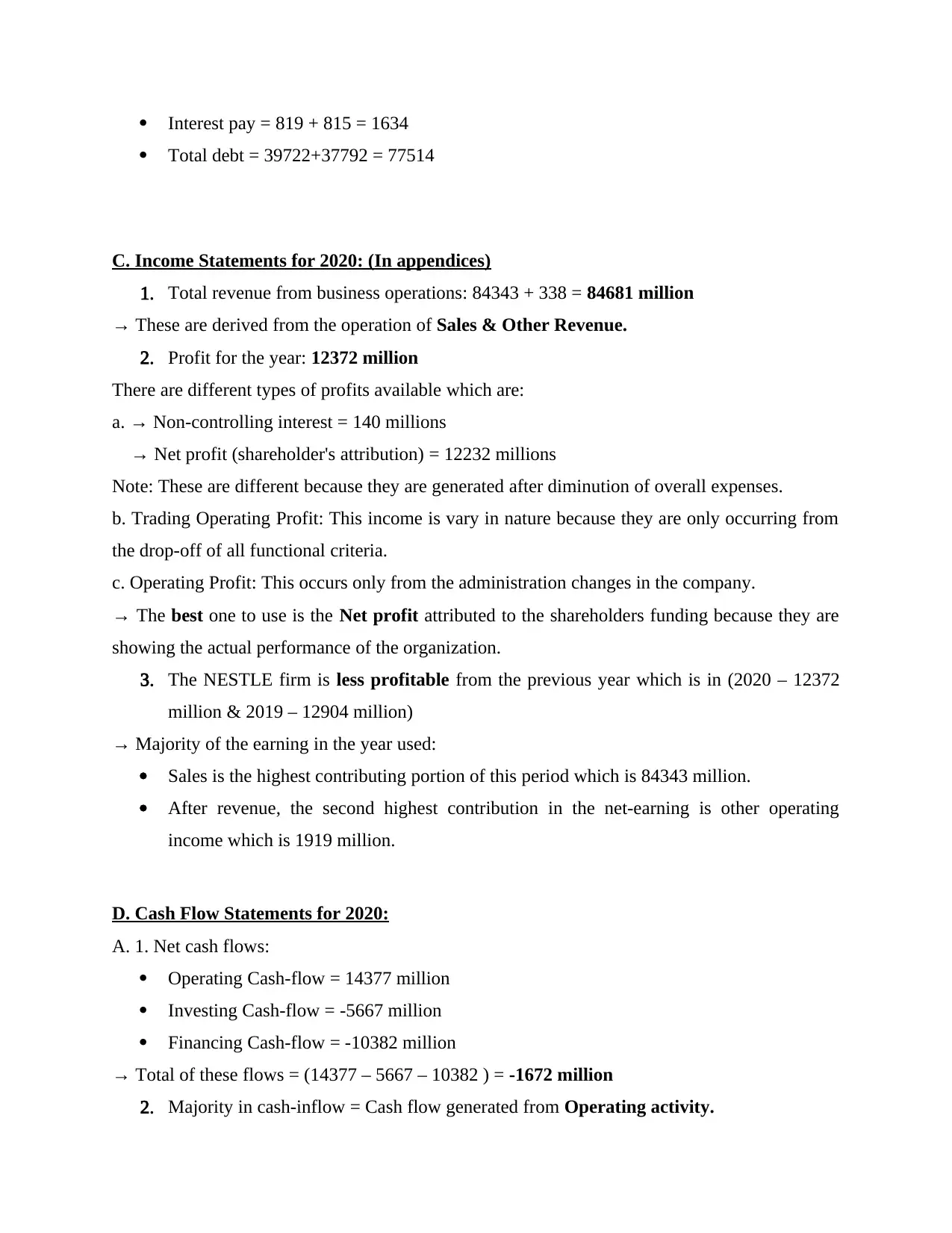
Interest pay = 819 + 815 = 1634
Total debt = 39722+37792 = 77514
C. Income Statements for 2020: (In appendices)
1. Total revenue from business operations: 84343 + 338 = 84681 million
→ These are derived from the operation of Sales & Other Revenue.
2. Profit for the year: 12372 million
There are different types of profits available which are:
a. → Non-controlling interest = 140 millions
→ Net profit (shareholder's attribution) = 12232 millions
Note: These are different because they are generated after diminution of overall expenses.
b. Trading Operating Profit: This income is vary in nature because they are only occurring from
the drop-off of all functional criteria.
c. Operating Profit: This occurs only from the administration changes in the company.
→ The best one to use is the Net profit attributed to the shareholders funding because they are
showing the actual performance of the organization.
3. The NESTLE firm is less profitable from the previous year which is in (2020 – 12372
million & 2019 – 12904 million)
→ Majority of the earning in the year used:
Sales is the highest contributing portion of this period which is 84343 million.
After revenue, the second highest contribution in the net-earning is other operating
income which is 1919 million.
D. Cash Flow Statements for 2020:
A. 1. Net cash flows:
Operating Cash-flow = 14377 million
Investing Cash-flow = -5667 million
Financing Cash-flow = -10382 million
→ Total of these flows = (14377 – 5667 – 10382 ) = -1672 million
2. Majority in cash-inflow = Cash flow generated from Operating activity.
Total debt = 39722+37792 = 77514
C. Income Statements for 2020: (In appendices)
1. Total revenue from business operations: 84343 + 338 = 84681 million
→ These are derived from the operation of Sales & Other Revenue.
2. Profit for the year: 12372 million
There are different types of profits available which are:
a. → Non-controlling interest = 140 millions
→ Net profit (shareholder's attribution) = 12232 millions
Note: These are different because they are generated after diminution of overall expenses.
b. Trading Operating Profit: This income is vary in nature because they are only occurring from
the drop-off of all functional criteria.
c. Operating Profit: This occurs only from the administration changes in the company.
→ The best one to use is the Net profit attributed to the shareholders funding because they are
showing the actual performance of the organization.
3. The NESTLE firm is less profitable from the previous year which is in (2020 – 12372
million & 2019 – 12904 million)
→ Majority of the earning in the year used:
Sales is the highest contributing portion of this period which is 84343 million.
After revenue, the second highest contribution in the net-earning is other operating
income which is 1919 million.
D. Cash Flow Statements for 2020:
A. 1. Net cash flows:
Operating Cash-flow = 14377 million
Investing Cash-flow = -5667 million
Financing Cash-flow = -10382 million
→ Total of these flows = (14377 – 5667 – 10382 ) = -1672 million
2. Majority in cash-inflow = Cash flow generated from Operating activity.
Paraphrase This Document
Need a fresh take? Get an instant paraphrase of this document with our AI Paraphraser
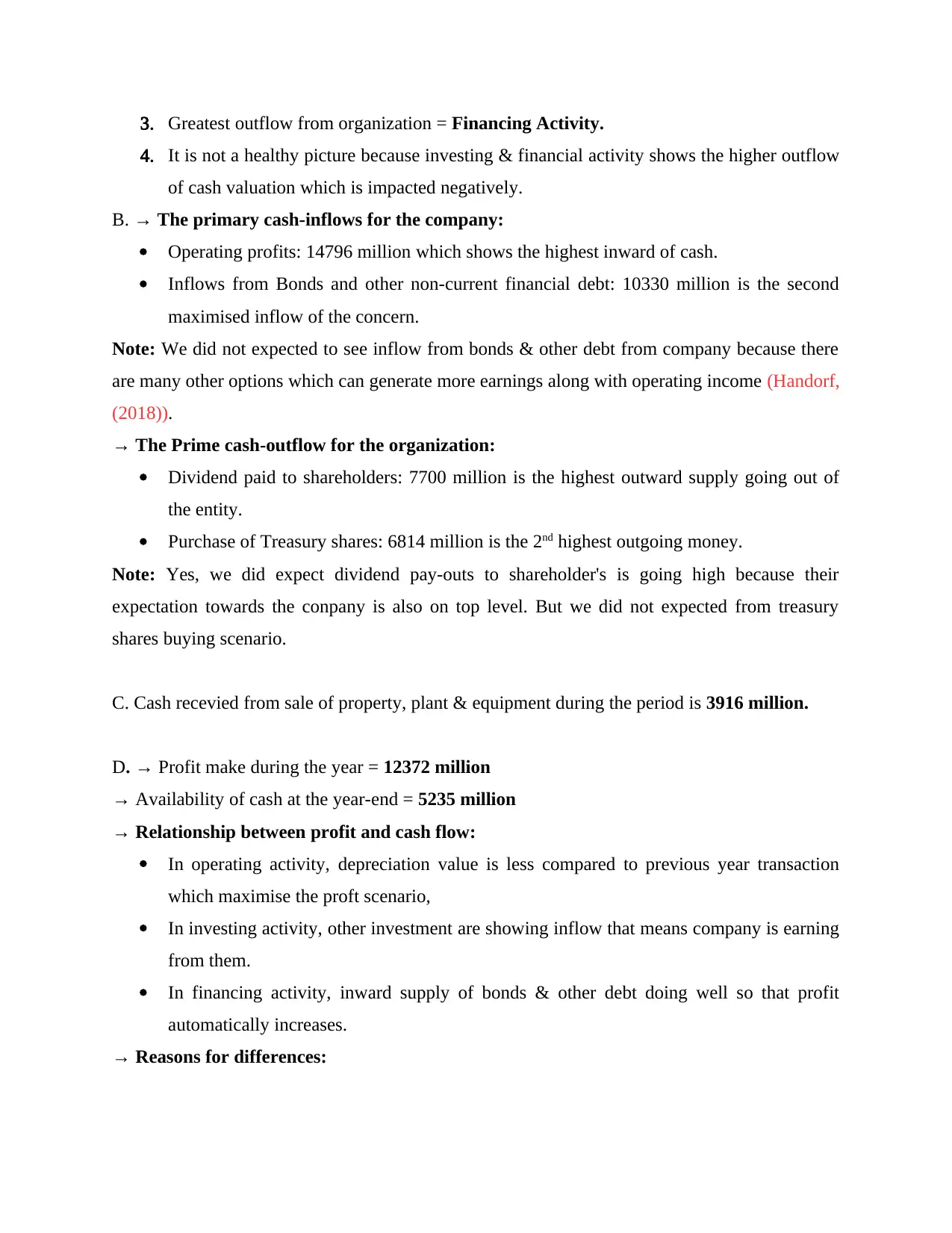
3. Greatest outflow from organization = Financing Activity.
4. It is not a healthy picture because investing & financial activity shows the higher outflow
of cash valuation which is impacted negatively.
B. → The primary cash-inflows for the company:
Operating profits: 14796 million which shows the highest inward of cash.
Inflows from Bonds and other non-current financial debt: 10330 million is the second
maximised inflow of the concern.
Note: We did not expected to see inflow from bonds & other debt from company because there
are many other options which can generate more earnings along with operating income (Handorf,
(2018)).
→ The Prime cash-outflow for the organization:
Dividend paid to shareholders: 7700 million is the highest outward supply going out of
the entity.
Purchase of Treasury shares: 6814 million is the 2nd highest outgoing money.
Note: Yes, we did expect dividend pay-outs to shareholder's is going high because their
expectation towards the conpany is also on top level. But we did not expected from treasury
shares buying scenario.
C. Cash recevied from sale of property, plant & equipment during the period is 3916 million.
D. → Profit make during the year = 12372 million
→ Availability of cash at the year-end = 5235 million
→ Relationship between profit and cash flow:
In operating activity, depreciation value is less compared to previous year transaction
which maximise the proft scenario,
In investing activity, other investment are showing inflow that means company is earning
from them.
In financing activity, inward supply of bonds & other debt doing well so that profit
automatically increases.
→ Reasons for differences:
4. It is not a healthy picture because investing & financial activity shows the higher outflow
of cash valuation which is impacted negatively.
B. → The primary cash-inflows for the company:
Operating profits: 14796 million which shows the highest inward of cash.
Inflows from Bonds and other non-current financial debt: 10330 million is the second
maximised inflow of the concern.
Note: We did not expected to see inflow from bonds & other debt from company because there
are many other options which can generate more earnings along with operating income (Handorf,
(2018)).
→ The Prime cash-outflow for the organization:
Dividend paid to shareholders: 7700 million is the highest outward supply going out of
the entity.
Purchase of Treasury shares: 6814 million is the 2nd highest outgoing money.
Note: Yes, we did expect dividend pay-outs to shareholder's is going high because their
expectation towards the conpany is also on top level. But we did not expected from treasury
shares buying scenario.
C. Cash recevied from sale of property, plant & equipment during the period is 3916 million.
D. → Profit make during the year = 12372 million
→ Availability of cash at the year-end = 5235 million
→ Relationship between profit and cash flow:
In operating activity, depreciation value is less compared to previous year transaction
which maximise the proft scenario,
In investing activity, other investment are showing inflow that means company is earning
from them.
In financing activity, inward supply of bonds & other debt doing well so that profit
automatically increases.
→ Reasons for differences:
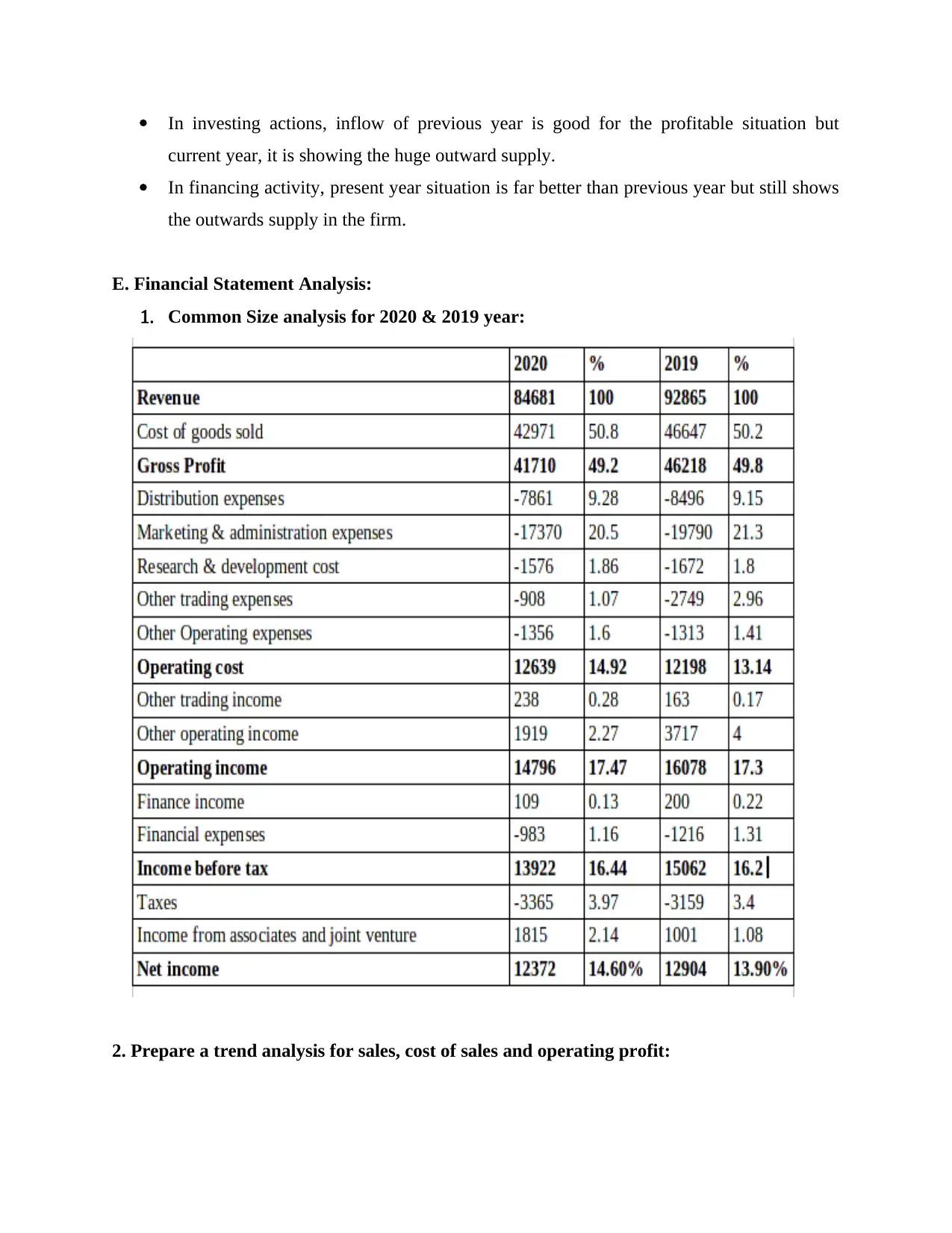
In investing actions, inflow of previous year is good for the profitable situation but
current year, it is showing the huge outward supply.
In financing activity, present year situation is far better than previous year but still shows
the outwards supply in the firm.
E. Financial Statement Analysis:
1. Common Size analysis for 2020 & 2019 year:
2. Prepare a trend analysis for sales, cost of sales and operating profit:
current year, it is showing the huge outward supply.
In financing activity, present year situation is far better than previous year but still shows
the outwards supply in the firm.
E. Financial Statement Analysis:
1. Common Size analysis for 2020 & 2019 year:
2. Prepare a trend analysis for sales, cost of sales and operating profit:
⊘ This is a preview!⊘
Do you want full access?
Subscribe today to unlock all pages.

Trusted by 1+ million students worldwide
1 out of 20
Related Documents
Your All-in-One AI-Powered Toolkit for Academic Success.
+13062052269
info@desklib.com
Available 24*7 on WhatsApp / Email
![[object Object]](/_next/static/media/star-bottom.7253800d.svg)
Unlock your academic potential
Copyright © 2020–2025 A2Z Services. All Rights Reserved. Developed and managed by ZUCOL.



